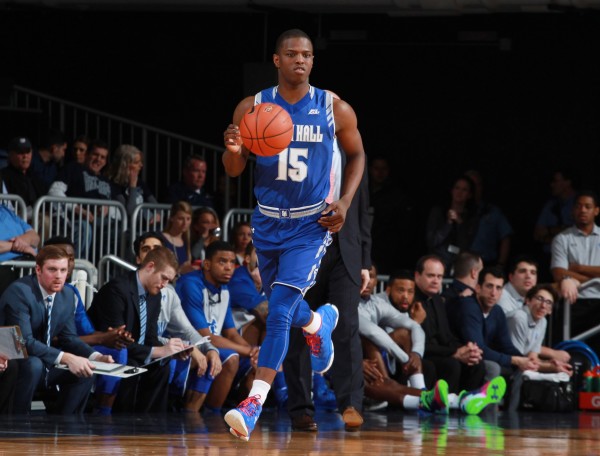Even Without Isaiah Whitehead, Seton Hall is Here to Stay
Posted by Justin Kundrat on October 25th, 2016Things took a turn for Seton Hall in the offseason when Isaiah Whitehead, the team’s leader and go-to scorer, opted to remain in the NBA Draft. Over the course of his two-year stint as a Pirate, the 6’4″ guard transformed from a ball-dominant, somewhat careless passer into one of the nation’s best combo guards. His 33.0 percent assist rate ranked 44th nationally and his savvy ability to get into the lane warped opposing defenses, summoning all help attention his way. In the wake of his departure, the prevailing concern is whether Kevin Willard‘s team can recoup its losses and turn in another Top 25 season. That sentiment is valid, but dropping the Pirates to a middle-of-the-pack conference contender and fringe NCAA Tournament team is overkill. There are a number of reasons why.
1. The team’s stout interior defense will be largely unchanged from last season as forwards Angel Delgado, Ismael Sanogo and Desi Rodriguez all return. It was easy to appreciate the Pirates’ offensive prowess when Whitehead was improvising and making unfathomable plays — even if the Seton Hall offense was remarkably average from a metrics standpoint. The real backbone of the team, however, was its defense — the 10th-most efficient unit in the country and one of the very best at altering opponents’ shots.
2. Junior forward Delgado is poised for a breakout campaign. While Whitehead was the key cog in last season’s offense, Delgado’s role was also substantial. Not only was he the Pirates’ best rebounder and interior defender, but the Seton Hall offense took a remarkable hit when he wasn’t on the floor (a difference of 0.15 points per possession).

To compensate for its poor outside shooting, Seton Hall generated numerous second chance scoring opportunities from offensive rebounds. Delgado and fellow stretch forward Sanogo were two of the conference’s best at that particular skill, helping the Pirates recover 37.1 percent of its misses (37th nationally). This portion of the offense will remain intact. Without Whitehead, Delgado’s usage rate will climb and it would be wise for Willard to feature his ultra-efficient forward on the offensive end.
Over the course of his two years in college, Delgado has figured out where his advantage lies and rarely deviates from it: 63 percent of his shots last season came at the rim, and he converted those attempts at a 66 percent clip. Whitehead’s ability to drive into the lane was a major component of his scoring opportunities, but there are plenty of other ways to involve him in the offense. A Delgado/Khadeen Carrington pick-and-roll would allow the big man to use his size to seal smaller defenders in the post while the guard’s speed attracts defensive attention. Another conceivable scenario is one in which the offense runs through Delgado in the post, similar in fashion to how Villanova used Daniel Ochefu last season. Low-post scoring threats with exceptional court awareness are hard to come by in college basketball.
3. As the newly-crowned point guard, Carrington is an underrated asset who has demonstrated good decision-making with the ball in his hands. The numbers won’t necessarily bear this out because Whitehead almost always initiated the offense, but Carrington flashed good passing and scoring abilities as an off-ball initiator.
It would be bold to think that Carrington will have the Seton Hall offense running as efficiently as Whitehead, but the transition should be relatively smooth since he already has two years of experience in Willard’s system. Nevertheless, his ability to make plays will be the biggest x-factor for this year’s team.
4. Incoming recruits Myles Powell and Eron Gordon will bolster the biggest hole in Seton Hall’s offense: outside shooting (34.7%). Last year’s backcourt thrived mostly by using its athleticism to blow by slower defenders, but when faced with big, low-post defenders that clogged the paint, the offense came to a screeching halt. The NCAA Tournament First Round loss to Gonzaga underlined this weakness (4-of-21 3FG) as there simply weren’t enough good shooters on the roster to stretch the floor. That should change with Powell and Gordon entering the mix as projected knock-down shooters. Adding them alongside Carrington will diversify the collective skill set of the backcourt and reduce the team’s over-reliance on dribble penetration and offensive rebounds. The offense should therefore see a boost in efficiency from having multiple shooting threats on the floor and giving Delgado some room to work in the post.
While NBA-caliber talent is often difficult to replace, Seton Hall is still in a good position to build on last season’s success. Willard isn’t facing a rebuilding in Newark; it’s a repositioning of the spotlight.











































